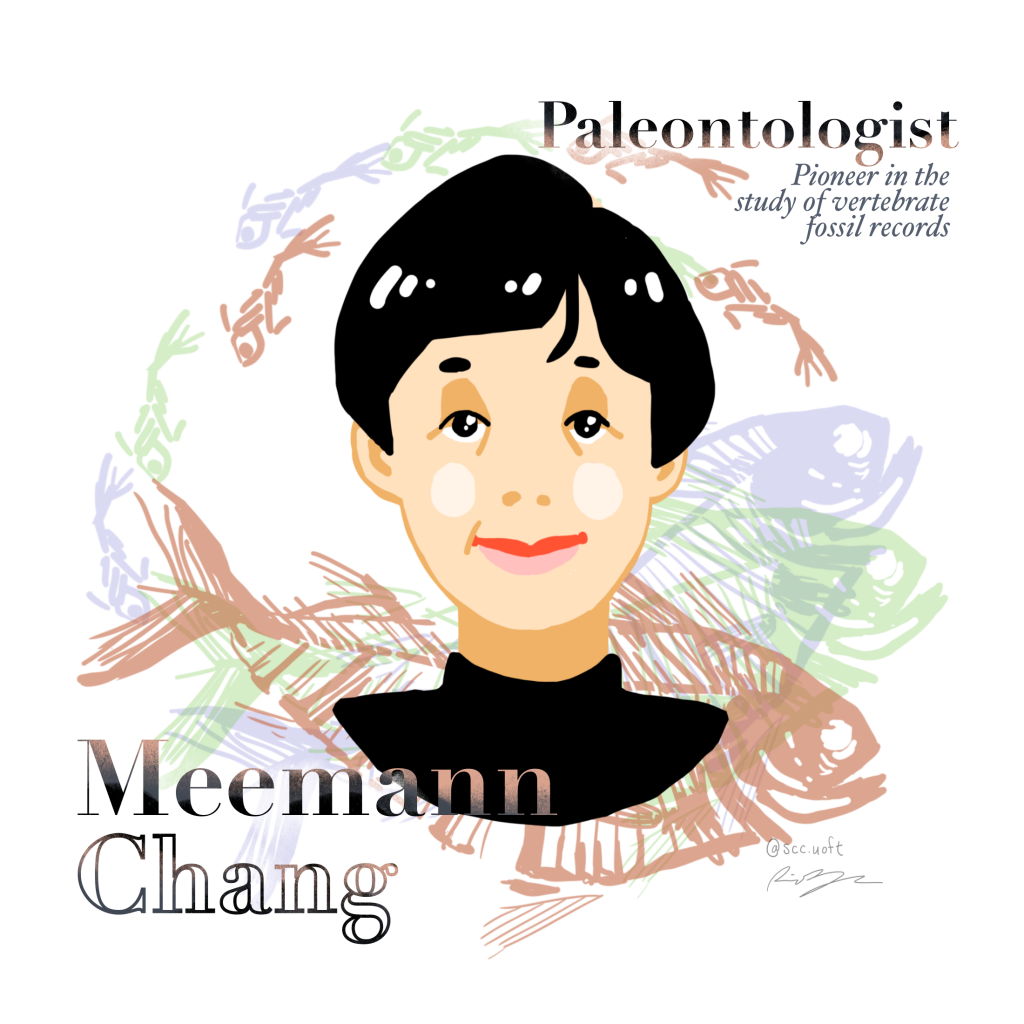
Written by Melissa Wong
Illustrated by Amy Zhang
There are two types of people in the world: people who like fossils, and liars. And what is there to dislike about fossils anyway? Just the thought of bizarre, alien-like creatures dominating the Earth long before the arrival of humans is an inherently cool idea; the fact that they vanished and left behind only fossils just adds to their mystery and intrigue. As humans, we’re always curious about things we don’t know and fossils, whether they’re of animals or plants, can tell us a ton about the history of life on Earth! How did these organisms evolve? Why have some creatures gone extinct and not others?And how did modern animals and plants come about from them? These are all questions that can be answered by looking into the past through fossils. The field of paleontology—the study of prehistoric life—has always been and continues to be a booming one due to the efforts of one of the modern pioneers of the field: Dr. Meemann Chang.
Being one the world’s hotspots for fossils, a lot of significant fossil finds have been discovered inChina, including that of the first known feathered dinosaur, Sinosauropteryx! However, this hasn’t always been the case, and it certainly wasn’t when Dr. Chang first began her studies. Having been born in 1936 to an intellectual family in Nanjing and being the daughter of a renowned neurophysiology professor, she’d always enjoyed science as a young child. Ironically,she wasn’t interested in fossils at first and didn’t join the field of paleontology voluntarily; she initially wanted to be a doctor before switching paths to focus on geology. But like many Chinese youth her age, her career was chosen for her and she was sent to study paleontology at Moscow University. She’d eventually earn her bachelor’s degree before returning to China and working at Beijing’s Institute of Vertebrate Paleontology and Paleoanthropology (IVPP). Despite being the only woman going out in the field and collecting fossils for the institute, she wasn’t treated differently and endured the same hardships as the men. It was during these trips that she developed an interest in fish fossils and sure, it wasn’t a Disney-esque tale of love at first sight, but it did inspire a life-long passion. And after over 60 years, Dr. Chang isn’t tired yet.
Of course, her journey wasn’t always smooth. Dr. Chang’s work was put on hold when the Cultural Revolution struck China in 1966; academic progress was buried and like many of her fellow intellectuals, she was sent to a labour camp where she remained imprisoned for nearly 15 years. There, she was forced to do gruelling physical labour and feared that she’d never have the chance to continue her studies. This article may have already spoiled it for you, but she did eventually continue her work once the Cultural Revolution ended, earning her doctorate and returning to her post at the IVPP to eventually become its first female head.
However, as China was recovering from the events of the revolution, the rest of the world moved on and with the advent of new technologies and significant fossil discoveries, the field of paleontology was undergoing a boom that saw new research and theories being published left and right. Not wanting to be left behind, Dr. Chang and other leading paleontologists in China diligently translated books and academic papers from English, making them accessible to the Chinese paleontologist community and building a rock-solid foundation for younger researchers.This effort eventually established China as a paleontology powerhouse.
While doing this, she didn’t neglect her own work; Dr. Chang’s research solidified our understanding of how vertebrate fish first migrated onto land. Humans and other tetrapods (land-based vertebrates) have two pairs of nostrils, an external pair and an internal pair called choanae which work together to help us breath through our lungs, something that we’ve inherited from our fishy prehistoric ancestors. For years, the widely-accepted theory was that porolepiforms, an order of prehistoric lobe-finned fish, had three pairs of nostrils, including one internal pair that eventually evolved into choanae. However, Dr. Chang found that Youngolepis—a genus, or group, of lobe-finned fish related to porolpiforms—had no internal nostrils, only two external pairs. Along with a student of hers, she later discovered the fossil of another lobe-finned fish, Kenichthys, in the Yunnan province in China that had two nostril pairs, one external pair and one pair between its front teeth. This perfectly supported her hypothesis that over generations, the second external pair of nostrils in lobe-finned fish slowly through the teeth to become choanae. This evolutionary transition allowed the first lungfish to breathe air, and it happened not in Europe or the Americas, but in China! This discovery rocked the field of paleontology and changed our understanding of how our ancestors first crawled onto land.
The contributions of Dr. Chang weren’t ignored. She was elected as the president of the International Paleontological Association in 1992, and of the Paleontological Society of China in 1993. In addition to being a scientist-in-residence at many universities and museums all over the world and having many species named after her (such as the extinct fish Meemannia), she has received many awards, including the Romer-Simpson Medal in 2016, the highest honour given to a paleontologist. But at the ripe age of 83, Dr. Chang feels like her work still isn’t done yet. She continues to study Mesozoic fish fossils in hopes of laying down the groundwork for discoveries by future paleontologists. In her own words: “I might not have the chance to see the result in my remaining days. But surely such work must be done”. And while this might be the case, as the ‘Rose of Chinese Science’, she remains an inspiration for her students and fellow paleontologists, and her contributions are etched into the field of paleontology as surely as fossils are etched into rock.
Sources:
- https://en.wikipedia.org/wiki/Meemann_Chang
- https://www.youtube.com/watch?v=r5tbA31Qb58
- https://www.smithsonianmag.com/science-nature/great-chinese-dino-boom-180968745/
- https://www.nature.com/articles/439262a
- http://www.newschinamag.com/newschina/articleDetail.do?article_id=3722§ion_id=39&magazine_id=31
- https://en.wikipedia.org/wiki/Cultural_Revolution#Education
- http://english.ivpp.cas.cn/ns/es/201105/t20110513_69779.html